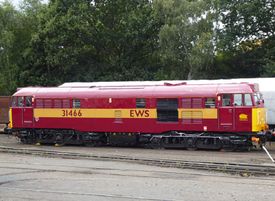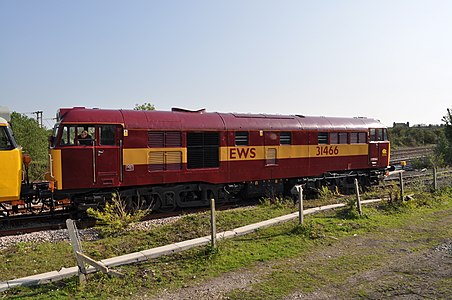BR Class 31 31466
| BR Class 31 31466 | |
|---|---|
 31466 at Kidderminster TMD, July 2021 | |
| Built By | Brush Traction |
| Configuration | A1A-A1A |
| Power type | Diesel-electric |
| Status | In service |
| Loco Number | 31466 |
| Other Numbers | D5533, 31115 |
| History | |
| Built | 1959 |
| Type | Class 31 |
| 2001 | Withdrawn and preserved |
| 2007 | Preserved on the DFR |
| 2021 | Arrived at the SVR on hire |
| Technical | |
| Length | 56ft 9in |
| Weight | 108-115 tons |
Contents
BR Class 31
The BR Class 31 diesel-electric locomotive was originally classified as the Brush Type 2. A total of 263 were built by Brush Traction between 1957 and 1962 as part of BR's early modernisation plans to replace steam locomotives. The Type were built with Mirrlees JVS12T engines as used in locomotives built for the then Ceylon Government Railways, but uprated from 1,250hp to 1,365hp. This, however, proved unreliable and the Type was rebuilt with the proven English Electric 12CSVT found in the Class 37.
The introduction of TOPS saw the type designated as Class 30, and when re-engined as Class 31.
The locomotives received a number of derogatory nicknames including Goyles (short for "gargoyles" in reference to the perceived ugliness of the design), Peds (short for "pedal cars" in reference to their speed and pulling power) and Gurglers, after the noise they made. 26 members of the class have been preserved[2].
Service
This locomotive entered service in June 1959 at Norwich Thorpe MPD numbered D5533. In April 1968 it was reclassified from Class 30 to Class 31 sub-type 31/1 (the standard locomotive fitted with steam heating and Blue Star electro-pneumatic control).[3]
The introduction of TOPS saw the locomotive renumbered as 31115 in January 1973. In March 1985 it was fitted with Electric Train Heating ('ETH'), becoming sub-type 31/4 and receiving its final number of 31466.[3] The ETH was sufficient to power eleven Mk3 carriages, the type 31s often being used to pre-heat a train in a depot before a more modern and powerful locomotive would carry out the day's inter-city duties.
By May 1988 the locomotive had served in BR's Eastern Region for all but a year. It was then transferred to Crewe Diesel, where it remained for a number of years.[3] Prior to the introduction of the Class 66, English Welsh & Scottish (EWS) took control of the Class 31s from the Mainline Freight and Trainload Freight companies. 31466 was repainted into EWS livery for the Toton TMD open day in May 1998; Wikipedia suggests it was then the only one of the class to be in traffic running in the EWS colours.[2]
Preservation
31466's last duties were at Old Oak Common where it was used for small shunt moves and carriage heating. After being withdrawn from service in February 2001 it stored there until being acquired from EWS by the Dean Forest Diesel Association (DFDA), arriving at Lydney on the Dean Forest Railway by low loader on 14 March 2007. After a number of small defects were addressed it operated its first service train in October of that year. It was repainted in EWS livery in 2009 and attended a gala at the Worth Valley Railway in 2012.[4]
31466 has remained resident on the Dean Forest Railway since.[5] Its 1470 hp English Electric twelve-cylinder diesel engine, which powers the generator supplying the DC motors on four out of the six axles (UIC classification A1A-A1A), has remained in working order throughout. A three year overhaul was completed by the DFDA in November 2020, which involved replacing entire sections of rotten or corroded cab with fresh metal or timber, renewing window surrounds and wiring, as well as re-painting in the EWS colours[6].
On 9 July 2021 31466 was collected from the DFR by 50049 Defiance and delivered to the SVR as cover for BR Class 33 33108.
See also
References
- ↑ SVR On-line Forum
- ↑ 2.0 2.1 BR Class 31 on Wikipedia
- ↑ 3.0 3.1 3.2 BRDatabase - 31466
- ↑ Dean Forest Diesel Association (retrieved 2 August 2021)
- ↑ Dean Forest Railway, Diesel Locomotives page
- ↑ Punchline Gloucester
Links
| ||||||||||||||||||||||||||||||||||||||||||||||||||||||||||||||||||||||||
